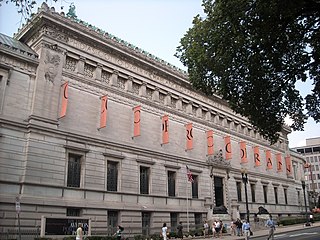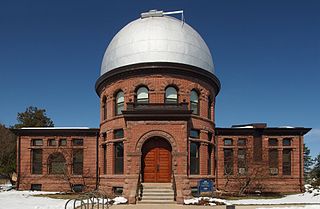
Dupont Circle is a historic roundabout park and neighborhood of Washington, D.C., located in Northwest D.C. The Dupont Circle neighborhood is bounded approximately by 16th Street NW to the east, 22nd Street NW to the west, M Street NW to the south, and Florida Avenue NW to the north. Much of the neighborhood is listed on the National Register of Historic Places. However, the local government Advisory Neighborhood Commission and the Dupont Circle Historic District have slightly different boundaries.

Foggy Bottom is a neighborhood of Washington, D.C., located in Northwest D.C. Stretching west of the White House towards the Potomac River, the neighborhood is home to numerous federal agencies and international institutions, while the core of the neighborhood is occupied by George Washington University.

Logan Circle is a historic roundabout park and neighborhood of Washington, D.C., located in Northwest D.C. The majority of Logan Circle is primarily residential, except for the highly-commercialized 14th Street corridor that passes through the western part of the neighborhood. In the 21st century, Logan Circle has been the focus of urban redevelopment and become one of Washington's most expensive neighborhoods. Today, Logan Circle is also one of D.C.'s most prominent gay neighborhoods.
Pediatric ophthalmology is a sub-speciality of ophthalmology concerned with eye diseases, visual development, and vision care in children.

LeDroit Park is a neighborhood in Washington, D.C. located immediately southeast of Howard University. Its borders include W Street to the north, Rhode Island Avenue and Florida Avenue to the south, Second Street NW to the east, and Howard University to the west. LeDroit Park is known for its history and 19th century protected architecture. The community's diversity entices new residents to the community, as well as its close proximity to the Shaw–Howard University Metro station and many dining options.

Massachusetts Avenue is a major diagonal transverse road in Washington, D.C., and the Massachusetts Avenue Historic District is a historic district that includes part of it.

The Christian Heurich Brewing Company was a Washington, D.C., brewery founded in 1872 and incorporated by Christian Heurich in 1890. First located near Dupont Circle on 20th Street NW, it expanded to a much larger site in Foggy Bottom in 1895 after a major fire. The new brewery was located along the Potomac River at 26th Street and D Street NW, where the John F. Kennedy Center for the Performing Arts now stands. The Heurich brewery was the largest in Washington's history, capable of producing 500,000 barrels of beer a year and 250 tons of ice daily.

Goodsell Observatory is an observatory at Carleton College in Northfield, Minnesota, United States. It was constructed in 1887 and was, at the time, the largest observatory in the state of Minnesota. The Goodsell Observatory and its predecessor, a smaller observatory that opened in 1878, served as a widely consulted timekeeping station, bringing national prominence to Carleton College in the late 19th and early 20th centuries.
Marshall Miller Parks was an American ophthalmologist known to many as "the father of pediatric ophthalmology".

The Sixteenth Street Historic District is a 1.25-mile (2.01 km) linear historic district in Washington, D.C., that includes all structures along 16th Street NW between H Street and Florida Avenue. The district's southern boundary is bordered by Lafayette Square, just north of the White House, and Meridian Hill Park on its northern boundary. It includes an eclectic mix of architectural styles on one of the city's most historic and important numbered streets including single and multi-family residential buildings, embassies, hotels, churches, and office buildings.

Heurich House Museum, also known as the Christian Heurich Mansion or Brewmaster's Castle, is a Gilded Age mansion in the Dupont Circle neighborhood of Washington D.C.

The Oak Hill Cemetery Chapel, also known as the Renwick Chapel or James Renwick Chapel, is a historic building in the Georgetown neighborhood of Washington, D.C., United States. Designed by James Renwick, Jr. in 1850, Oak Hill Cemetery Chapel is the architect's only known example of Gothic Revival church architecture in Washington, D.C. It is located on the highest ridge in Oak Hill Cemetery, near the intersection of 29th and R Streets NW. The chapel is one of two structures in Oak Hill Cemetery listed on the National Register of Historic Places, the other being the Van Ness Mausoleum. The chapel, mausoleum, and cemetery are contributing properties to the Georgetown Historic District, a National Historic Landmark.

The following outline is provided as an overview of and topical guide to District of Columbia:

Appleton Prentiss Clark Jr. was an American architect from Washington, D.C. During his 60-year career, Clark was responsible for designing hundreds of buildings in the Washington area, including homes, hotels, churches, apartments and commercial properties. He is considered one of the city's most prominent and influential architects from the late 19th and early 20th centuries. Many of his designs are now listed on the National Register of Historic Places (NRHP).

Tingey House, officially known as Quarters A, is the official residence of the Chief of Naval Operations of the United States Navy. Built in 1804, it is located at the Washington Navy Yard in Washington, D.C., and is part of the Yard's historic Officers Quarters. The residence is known as Tingey House in honor of its first resident and yard commandant, Commodore Thomas Tingey. According to popular legend, Tingey's ghost haunts the property.
Christian Heurich was an American brewer and real estate investor in Washington D.C. His company, Christian Heurich Brewing Company, established in 1872, was the largest brewery in Washington, D.C. At one point, Heurich owned more land than any other landowner in Washington, D.C., except the federal government.
Heurich is a surname. Notable people with the surname include:

Albert L. Harris was an American architect who worked primarily in Washington, D.C. He was born in Wales and emigrated to the United States as a young child. He worked for architectural firms in Chicago and Baltimore and then Washington, where he also obtained an architectural degree from George Washington University. He was a part-time professor there while also working for the US Navy and then the city of Washington where he served as the city's Municipal Architect from 1921 until his death in 1933. A number of his works are listed on the National Register of Historic Places (NRHP).

The Codman Carriage House and Stable is a historic building located at 1415 22nd Street NW in the Dupont Circle neighborhood of Washington, D.C. The industrial building was constructed in 1907 as a carriage house and stable for socialite and art collector Martha Catherine Codman, who lived a few blocks north in her home, later known as the Codman–Davis House. She commissioned her cousin, Ogden Codman Jr., an architect and prominent interior decorator who also designed her home. He designed it in a Second Empire style.



















